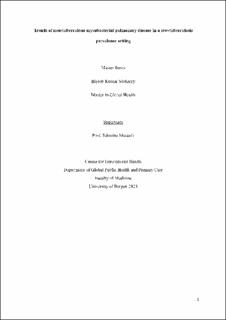| dc.description.abstract | Background: Limited data are available regarding factors associated with initiation of treatment and treatment outcomes after diagnosis of non-tuberculous mycobacteria (NTM) pulmonary infection and disease. Objective: To investigate trends of NTM pulmonary infections, patient characteristics and factors associated with initiation of treatment and treatment outcomes in patients with NTM pulmonary infection and disease. Methods: We evaluated 154 patients with NTM pulmonary infection, identified by having at least one record coded with ICD-10 A31.0 at Haukeland University Hospital in Bergen, Norway, from 2000 to 2021. A univariate and multivariate binary logistic regression was carried out to find the odds of factors associated with the initiation of treatment and treatment outcomes. Results: 70% of the patients were older than 65 years. 49 % of patients had pulmonary comorbidity and the three most common symptoms were cough, dyspnoea, and weight loss. The most frequently observed mycobacterial species was M. avium complex (MAC), followed by M. malmoense, and M. abscessus. There was a decreasing trend in NTM pulmonary infection and NTM pulmonary disease from the year 2000 to 2014, while an increase was observedfrom 2015 to 2019. A total of 72 (47%) patients received antibiotic treatment. Patients with high symptom scores, those below the age of 65, and those with MAC infection had more than three times the odds of receiving antibiotic treatment (P = 0.006, P = 0.006, and P = .005 respectively). Of 72 patients who received treatment, 53 (74%) had a favourable response and culture conversion. 17 (32%) of them had a relapse. Out of 82 patients who did not receive treatment, 45 (55%) had spontaneous culture conversion. 8 (18%) of them had a relapse. No factor was identified to be significantly associated with a favourable treatment response including the time taken to start treatment or presence of pulmonary cavities. Conclusion: Favourable response to treatment was seen in 74% patients whereas spontaneous culture conversion was seen in 55% of non-treated patients. Factors associated with favourable treatment response were not found. | |
